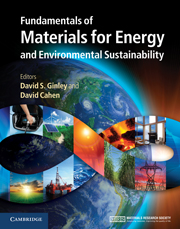Book contents
- Frontmatter
- Contents
- Contributors
- Preface
- Acknowledgments
- Part 1 Energy and the environment: the global landscape
- Part 2 Nonrenewable energy sources
- Part 3 Renewable energy sources
- Part 4 Transportation
- Part 5 Energy efficiency
- Part 6 Energy storage, high-penetration renewables, and grid stabilization
- 42 Toward the smart grid: the US as a case study
- 43 Consequences of high-penetration renewables
- 44 Electrochemical energy storage: batteries and capacitors
- 45 Mechanical energy storage: pumped hydro, CAES, flywheels
- 46 Fuel cells
- 47 Solar fuels
- 48 Solar thermal routes to fuel
- 49 Photoelectrochemistry and hybrid solar conversion
- Summary
- Appendix A Thermodynamics
- Appendix B Electrochemistry
- Appendix C Units
- Index
- References
45 - Mechanical energy storage: pumped hydro, CAES, flywheels
from Part 6 - Energy storage, high-penetration renewables, and grid stabilization
Published online by Cambridge University Press: 05 June 2012
- Frontmatter
- Contents
- Contributors
- Preface
- Acknowledgments
- Part 1 Energy and the environment: the global landscape
- Part 2 Nonrenewable energy sources
- Part 3 Renewable energy sources
- Part 4 Transportation
- Part 5 Energy efficiency
- Part 6 Energy storage, high-penetration renewables, and grid stabilization
- 42 Toward the smart grid: the US as a case study
- 43 Consequences of high-penetration renewables
- 44 Electrochemical energy storage: batteries and capacitors
- 45 Mechanical energy storage: pumped hydro, CAES, flywheels
- 46 Fuel cells
- 47 Solar fuels
- 48 Solar thermal routes to fuel
- 49 Photoelectrochemistry and hybrid solar conversion
- Summary
- Appendix A Thermodynamics
- Appendix B Electrochemistry
- Appendix C Units
- Index
- References
Summary
Focus
We are all familiar with small-scale electrical energy storage in chemical batteries, from cars to cell phones. Batteries offer near-instant response time, but cost tends to scale linearly with size, making very large batteries or systems of batteries prohibitively expensive. Mechanical energy storage, in contrast, tends to be inexpensive at large scales due to the use of relatively low-cost materials (e.g., concrete and steel) and low-cost storage media (e.g., water, air), and due to long device lifetimes. The levelized cost of energy (LCOE), which is essentially the break-even selling price per kilowatt-hour (kWh) including all lifetime costs, for pumped-hydroelectric and compressed-air storage can be much less than for smaller-scale technologies such as batteries.
Synopsis
Electrical energy can be converted into any of the three forms of mechanical energy: gravitational potential, elastic potential, or kinetic. Each of these can, in turn, be converted back to electricity. In principle, though never in practice, interconversion can be 100% efficient. The most common mechanical energy-storage technologies are pumped-hydroelectric energy storage (PHES), which uses gravitational potential energy; compressed-air energy storage (CAES), which uses the elastic potential energy of pressurized air; and flywheels, which use rotational kinetic energy.
- Type
- Chapter
- Information
- Publisher: Cambridge University PressPrint publication year: 2011



